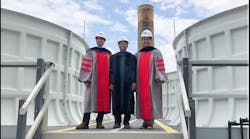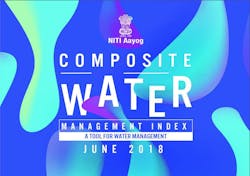In case you missed the Editor's Note in HPAC Engineering's June issue, it's worth a read. Entitled #InfrastructureWeek Must be More Than a Punchline, the short essay by HPAC's Rob McManamy doesn't pull any punches in describing the seriousness of our collective lack of response to the nation’s failing infrastructure. He closes with a reference to the American Society of Civil Engineers' 2017 Infrastructure Report Card, which gave the drinking water in the U.S. a grade of ‘D’. According to the report, almost six billion gallons per day of treated drinking water is lost due to aging, failing pipes…enough to provide drinking water to some 15 million households!
Of course, the water crisis in this country – and the rest of the world – is not new news. As I’m writing this, we’re learning that India also is facing the worst water crisis in its history. According to a report from the National Institution for Transforming India (Niti Aayog), a government think-tank, approximately 600 million Indians will face acute water shortages. A number of Indian cities and towns already face water shortages each summer due to poor infrastructure in their water distribution systems.
Water conservation measures have helped alleviate the problem here in the U.S., but until the infrastructure issues are addressed, those reductions are literally only a drop in the bucket. Political will can make it happen. Michigan, in response to the Flint water crisis, recently enacted the strictest standards in the U.S. for lead in drinking water, and intends to replace all 500,000 lead service pipes in the state. In July 2013, I bragged in this space about Broward County FL for passing two local amendments to the Florida Building Code that made Broward a national leader in water conservation. One of those amendments addressed cooling tower water treatment, raising the minimum cycles-of-concentration (COC) for new cooling towers to 8. With most systems operating at around 3 COC, and the most stringent standards then in effect requiring 5 COC, that initiative – along with a requirement to recover the condensate and use it onsite for cooling tower makeup – was expected to save as much as 7.5 million gallons per day (MGD).
Although HVAC cooling towers consume relatively large quantities of water, in order to makeup the losses from blowdown (bleed), drift, and evaporation, they represent only a fraction of the water consumed by utility power plant cooling towers. The primary difference between them, in addition to quantity of water consumed, is that most HVAC cooling towers use potable water and power plant cooling towers generally rely on fresh water from reservoirs, lakes, and rivers.
A breakthrough in power plant cooling tower water conservation has recently been announced by the Massachusetts Institute of Technology (MIT). A June 8, 2018, release by David L. Chandler in the MIT News Office describes how MIT engineers have developed a system that harvests large amounts of water from power plant cooling towers. The water is captured from the cooling tower plume using an ion beam to electrically charge the water droplets and collect them on a wire mesh that is then drained to a collector. Since the recovered water is essentially distilled, it can be treated and distributed as potable water or used for other potable water applications.
- Pictured at top: Kripa Varanasi, associate professor of mechanical engineering, MIT, flanked by the two doctoral students who led the research project, Maher Damak (left) and Karim Khalil (right). (Photo credit: Melanie Gonick/MIT)
According to last year’s report by the World Health Organization, approximately 30 percent of the world’s population – 2.1 billion people – do not have reliable access to safe drinking water in their homes. Most Americans do enjoy clean drinking water, but many are struggling to afford it and, as it becomes scarcer, it will be even more expensive. We will not solve our own – and the world’s – water problems by conservation alone. To do so, we must invest in critical infrastructure improvements and support the research and development of new technologies.
A regular contributor to HPAC Engineering and a member of its editorial advisory board, the author is a principal at Sustainable Performance Solutions LLC, a south Florida-based engineering firm focusing on energy and sustainability. He can be reached at [email protected].










